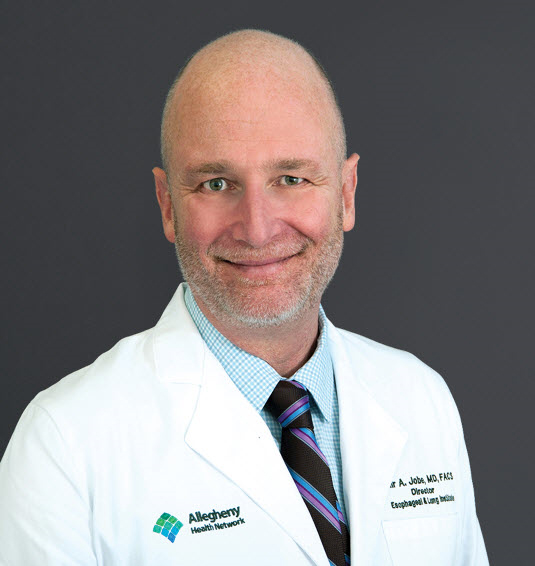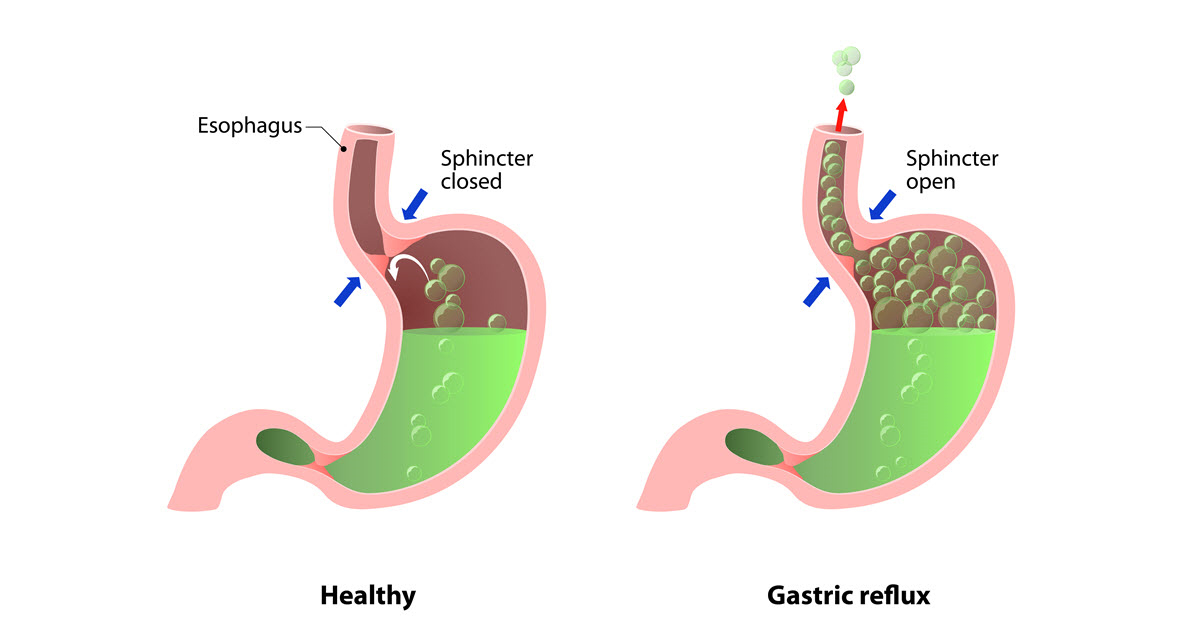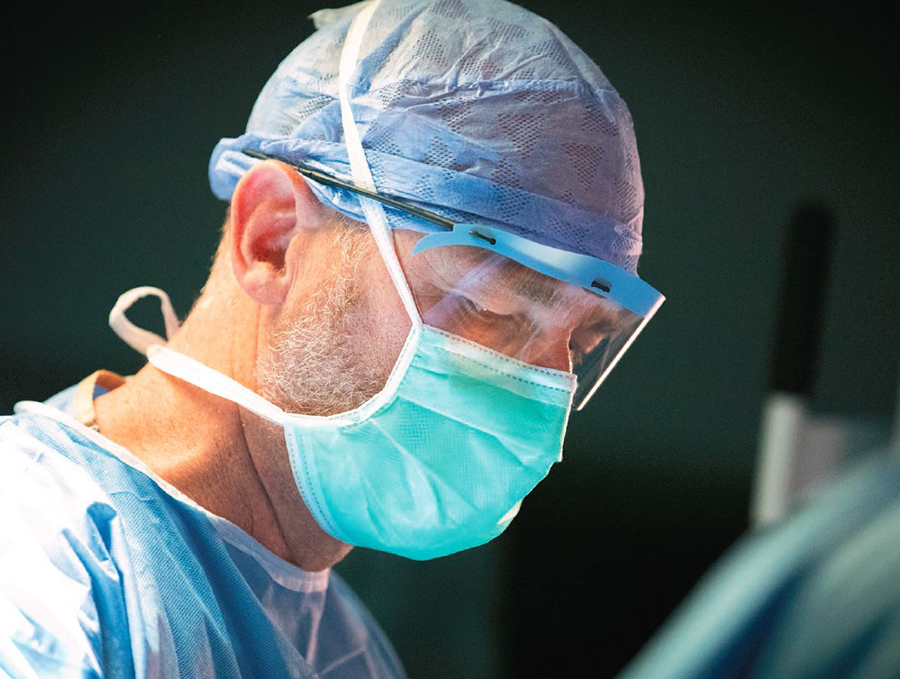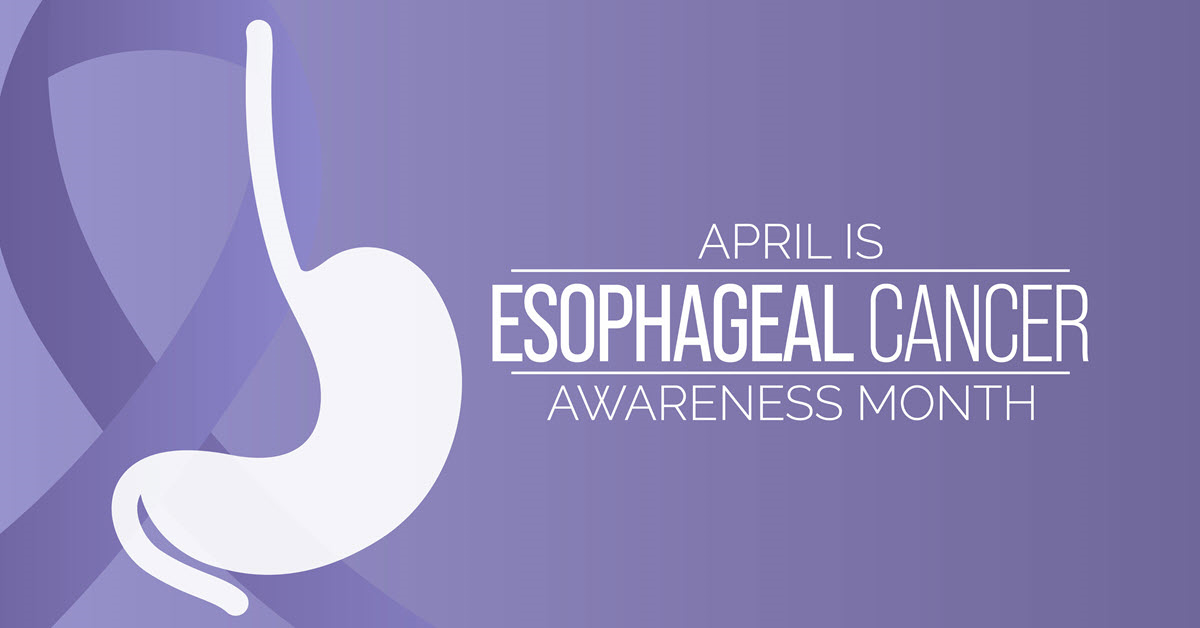Editor's Update: This article was first published March 26, 2021. It was most recently reviewed and updated February 17, 2023.
In our Ask a Doc series, we sit down with physicians and other clinical experts, including those at Allegheny Health Network (AHN), for a chat on an important health topic. In this interview, Dr. Blair Jobe discusses esophageal cancer.

Dr. Blair Jobe, director of the AHN Esophageal Institute.
Dr. Blair Jobe, director of the Allegheny Health Network (AHN) Esophageal Institute, says that esophageal cancer is relatively rare in the U.S. when measured by prevalence (number of people with a condition on a specified date). But, he adds, when he began specializing in it, the incidence rate (number of newly diagnosed cases per 100,000 population per year) had been rising faster than almost any other cancer.
“It has also been somewhat of an ‘orphan cancer’ in terms of federal research funding,” he says. “All of this was, and is, of interest to me, and I’ve focused on trying to figure out better screening, early detection, risk stratification, and treatment. People think if you get esophageal cancer, you’re not going to survive, but we now know that each tumor is genetically unique, and the genetics predict how it will respond to therapy. We have seen people with advanced stage disease live long lives and be cured.”
Unlike breast cancer, colon cancer, and prostate cancer, there is no preventive schedule for average-risk Americans to get screened for esophageal cancer. Check the sidebar at the right of this article (or scroll to the bottom on mobile devices) for a quick, simple summary of risk factors and symptoms you should report promptly to be considered for an endoscopic screening. Read on for my full conversation with Dr. Jobe — including discussing the connection between esophageal cancer and a much more common condition: gastroesophageal reflux disease (GERD).

Although still rare, there has been a rising incidence rate of esophageal adenocarcinoma, a type of cancer linked with a condition that is very common: reflux disease.
Emily Adamek: Can you start by explaining the link between reflux disease, which is common, and esophageal cancer?
Dr. Blair Jobe: There are two forms of esophageal cancer. One, squamous cell carcinoma, is usually related to drinking and smoking. The other, esophageal adenocarcinoma, is related to reflux disease, and has a growing incidence rate, including among people under 50.
GERD is the breakdown of the barrier, a specialized muscle, at the junction of the esophagus and stomach that allows gastric juice — which has acid and digestive enzymes — to move through. The stomach loves these juices, but the esophagus does not. So, if that barrier breaks down, you can develop a state of chronic inflammation related to the irritation of the lining.
That sets the stage for a potential progression from inflammation to what is called Barrett’s esophagus — a premalignant risk factor for developing esophageal cancer. Barrett’s involves a change in the lining of the esophagus. The fundamental cell type changes — essentially, the esophagus says, “Well, if you’re going to treat me like the stomach, I’m going to become more like the stomach.”
We have a huge number of people with GERD. Estimates are that about 10-15% will develop Barrett’s esophagus, and a small percentage develop cancer after that.
Emily Adamek: So, in terms of reducing risk for esophageal adenocarcinoma, what causes the breakdown of the barrier at the start of that progression?
Dr. Blair Jobe: That’s the million-dollar question. No one really knows the root cause of the breakdown of the muscle. However, several things are highly associated with it in clinical studies. First, obesity. That makes sense, because your intra-abdominal pressure goes up, impacting the sphincter at the upper esophagus. Distension of the stomach does this too, so overeating or large meal size is another risk for GERD, and for a hiatal hernia, which is when the upper part of your stomach bulges up through the muscle and into the esophagus.
As I was told growing up, everything in moderation. Other ways to reduce risk are to eat a diet high in leafy green vegetables and limit animal fats. Weight reduction, weight maintenance, and exercise are important. Smoking and drinking are risk factors. And if you do develop GERD, there’s reflux control to prevent it from getting worse. That’s not necessarily just medication — it could also be surgery.
Emily Adamek: What are the pros and cons of medication versus surgery?
Dr. Blair Jobe: There is debate and conflicting evidence over the medications people take for reflux. Some research says the medications are protective, but other research suggests that they could actually contribute to the development of reflux by rendering patients asymptomatic despite continued inflammation.
If you think about it, the medication just changes the chemistry of fluid that continues to reflux into the esophagus. The medication works on the acid that makes people feel heartburn, but you also have digestive enzymes and inflammatory substances like bile and weak acid. So with medication, there is still inflammation, but now the patient doesn’t feel it, nothing else is done to stop the progression, and they may develop Barrett’s.
Emily Adamek: Is the takeaway to avoid medication for reflux… and consider surgery if it gets worse?
Dr. Blair Jobe: Well, we need to remember that on a weekly basis about 20% of Americans will experience reflux. Are we going to operate on all those people? No. Many people take medication to cope, and that’s probably OK. But if you’re taking it regularly, for long periods of time, the risk I mentioned is something to consider.
Surgical options to repair the broken sphincter can eliminate or cure reflux, and we think it can prevent the development of cancer. We have evidence, but it’s not definitive yet, because the end point of measurement — esophageal cancer — is so rare.
The deeper question isn’t surgery versus medication, it’s how do we stratify the risk of developing cancer within that huge group of patients? It’s a haystack, and we’re looking for needles.

Dr. Blair Jobe at work.
Emily Adamek: Are there early symptoms people should be aware of to help with that haystack search?
Dr. Blair Jobe: Difficulty swallowing, ongoing need for antacid medications, or coughing/vomiting blood are all reasons to talk to your doctor, and then the next step is often an upper endoscopy.
Here’s the challenge: 40% of patients who develop esophageal cancer related to reflux never experience reflux symptoms. They never knew they had reflux. There’s also no general population screening for esophageal cancer. The thinking, influenced by cost certainly, is that it doesn’t make sense to have 20 million Americans get an upper endoscopy if you’re only going to find a few thousand cases of cancer.
This all contributes to why esophageal cancer is often discovered late. The esophagus is a distensible tube. You may not have symptoms as the cancer begins growing a ring around the esophagus wall. It’s only after that ring is encasing the tube that you experience food obstruction or other symptoms, and so that’s usually a late diagnosis.
The stakes are high, and the onus is on clinicians to better identify who needs to be screened.
Emily Adamek: Is there technology to make early identification easier?
Dr. Blair Jobe: Several companies have introduced solutions. With one we use in our clinic, the patient swallows a pill attached to a string. In about seven minutes, the capsule dissolves, releasing a sponge, which the nurse pulls out by the string. You send the sponge to a lab for genetic analysis, and you can tell if the patient has Barrett’s.
If the test shows that a patient has Barrett’s, now we scope and take tissue to confirm. There is also technology that allows us to take that biopsy sample and analyze it to determine whether the person is at low, medium, or high risk of their Barrett’s turning into cancer. When we find someone who is high risk, we can treat that with an outpatient procedure.
If we could identify all the patients who have Barrett’s, we could put them into a surveillance program. The capsule and sponge test, which can theoretically be done in a primary care setting, gives us a first step toward that identification without needing to do an endoscopy on everyone.
Emily Adamek: What are the treatment options and expected outcomes with esophageal cancer?
Dr. Blair Jobe: That is all predicated by staging. First, we have to understand whether or not the tumor has invaded the wall of the esophagus, whether or not lymph nodes are involved, and whether the tumor has spread to sites beyond the area of original cancer.
One way we do that is an endoscopic ultrasound, which goes down into the esophagus and takes images through the wall so we can see the tumor and how deep it goes. We’re also able to look at and biopsy regional lymph nodes to tell whether there is nodal spread, which is an independent predictor of survival and recurrence rates.
Another option is a PET CT scan. We give a patient labeled glucose, and because the cancer cells take up glucose quicker than normal cells, you’ll have an area of imaging that lights up orange. That can tell us whether you have the disease outside the esophageal bed or lymph nodes.
Once you have the clinical stage, you determine the treatment. Let me give you some high-level examples.
An early-stage cancer means it is just in the most superficial lining of the esophagus. In rare cases, that may be treatable just with an endoscopic procedure. But whatever treatment we do, early-stage cases are good to see because that’s where we have the best chance to save a life.
The next group of people have more advanced disease, but it’s confined to the esophagus and surrounding lymph nodes. Those patients tend to undergo chemotherapy and/or radiation therapy prior to surgery. We call that trimodality therapy.
The third group has advanced disease, stage 4. Those patients usually undergo chemotherapy with the hope of palliation. We focus on alleviating symptoms related to the tumor and improving quality of life. It doesn’t mean we don’t go for a cure, but the chances of the patient surviving at this stage are pretty low.

Emily Adamek: It sounds like this cancer is still shrouded in a bit of mystery. What is promising in terms of research to understand it or future advances?
Dr. Blair Jobe: There’s a lot of work to be done, but also amazing things already being done. What we really need to be able to do is draw someone’s blood to know if they have cancer in their bloodstream. The blood test is the holy grail for us, and a research team here at AHN has done work in that area.
Clinical trials in immunotherapy are big news. We have a lab at AHN that covers the whole gamut of investigation. With immunotherapy — a way of enhancing the immune system to attack and fight cancer — one drug we’ve tested is Nivolumab. It’s been widely used in melanoma, and it’s a big player in lung cancer. We were one of the first to develop this protocol and look at the safety of using it in treating patients with esophageal cancer. We did that in conjunction with Johns Hopkins, but the ideas and the genesis of the research came from our lab. It’s still in progress, but we’ve taken that idea from inception, to an animal model, and now to humans.
Emily Adamek: Is there anything else you’d like people to know?
Dr. Blair Jobe: There’s a lot to discuss, but it’s important to emphasize that the patient is at the center of everything at our clinics — diagnostics, therapy, and recovery. Each week we have a tumor board where everyone involved meets to talk about each patient — it’s the definition of individualized care. We bring patients in regularly and surround them with all the different care experts, not just doctors and nurses, but dietitians, psychologists, speech pathologists, and others. Our esophageal cancer patients become like family.